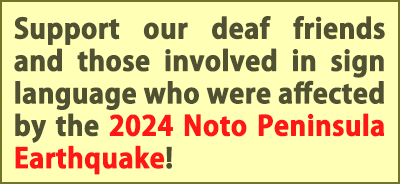By Eiichi Takada – August 25, 2004
(English translation based on an article which appeared in the Oct. 25, 2004 edition of the Yomiuri Shimbun Newspaper)
The United Nations Ad Hoc Committee on a “Comprehensive and Integral International Convention on Protection and Promotion of the Rights and Dignity of Persons with Disabilities” is now in the process of discussing the contents of the convention. The Fourth Session of the Ad Hoc Committee, held from August 23 to September 3, was attended, not only by the Japanese government delegation, but also by a delegation of Japanese disability-related NGOs.
As the common desire of all the Deaf persons or persons with profound hearing disabilities throughout the world, the Deaf community is now focusing on the need to define sign languages as full-fledged languages.
It is true that sign language is becoming better understood by society at large, and people no longer look at us with curiosity when we are signing in public. Sign language often appears even in TV dramas. Most people, however, mistakenly believe that sign language is an alternative form of expressing spoken languages. Sign languages are still discriminated in that they are not recognized to be languages, equal to spoken languages.
For example, the use of sign language is not guaranteed in education. Sign language interpretation is not guaranteed in employment examinations for government or civil-service employees. It is not even guaranteed in court trials. This situation results in a deprivation of the rights of the Deaf.
There is theoretical proof that sign languages are languages, and that they are to be distinguished from mime or gestures. Sign languages have a rich vocabulary to enable people to express whatever must be expressed in life. Moreover, the ability to interpret fully between spoken languages and sign languages is proof that sign languages are indeed languages.
According to the latest data, there are about 6,700 spoken languages and about 157 sign languages in the world. Although some countries like Portugal and South Africa legally recognize the country’s sign language, and countries like France are in the process of adopting legislation to recognize sign language, the number of countries that legally recognize sign language to be one of the official languages of its country is still very small.
This is due to the fact that the linguistic experience of the hearing society is limited to spoken languages, and to the lack of awareness and indifference of the hearing society toward the existence of any other form of language. Another remote cause may be found in the history of Deaf education. Throughout the world, the history of Deaf education is a history of conflict between oral education (which denies the use of sign language and tries to educate Deaf children to speak and to lip-read what is spoken) and sign language education (which is not opposed to the use of spoken languages but recognizes the need to use sign language as well.)
In Japan, the government’s education policy took a decisive turn in the direction of oral education in the early days of the Showa Era (1920’s), and many Deaf teachers lost their jobs. Even after World War II, the influence of pedagogues who adamantly adhered to oralism, and the conservative attitude of the administrative sector and their reluctance to change established ways, prevented sign language from winning recognition as a language.
To avoid misunderstanding, I wish to point out that sign language is not opposed to spoken languages. Deaf people do not deny the need for spoken languages. Spoken languages consist of the spoken form and a secondary written form. Deaf people understand the need to acquire written language and know that it is possible for them to acquire writing skills. In fact, even though the Deaf cannot lip-read what is being spoken, the written medium has enabled many Deaf people throughout the world to take up such professions as layers university professors, researchers, government officials, etc.
The problem for the Deaf lies in spoken communication. This is something that cannot be acquired by the Deaf. In order for people to speak, they must first be able to hear. Because the Deaf cannot hear, they cannot speak correctly. If a hearing person never once heard the English language being spoken, would he be able to speak it correctly?
Lip-reading is just as impossible. Hearing people can put their hands to their ears and see how impossible it is to lip-read what is being spoken. If it is impossible for the hearing, it is also impossible for the Deaf. There is no Deaf person who has mastered oralism – who can speak and lipread with ease. Oral education has been pushing this impossible task on Deaf children and students.
From the UN International Year of Disabled Persons in 1981, the world changed its concept from “social adaptation” to “full participation and equality”. The many years of fruitless and meaningless efforts to force persons with disabilities to adapt to society finally began to change to a new age of “full participation and equality”. For the Deaf, the new age guaranteed sign language interpretation. By giving sign language its due recognition, and by defining it to be a full-fledged language, “full participation and equality” for the Deaf will be further enhanced.
Eiichi Takada
Honorary Board Member of the World Federation of the Deaf
Board Member of the Japanese Federation of the Deaf
Managing Director of the National Center of Sign Language Education


